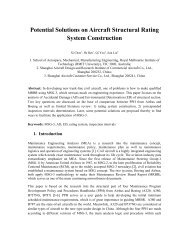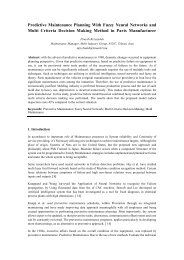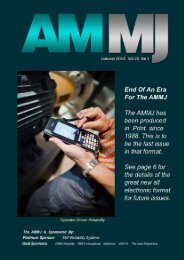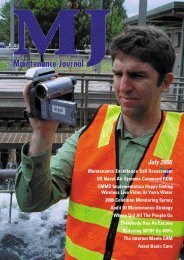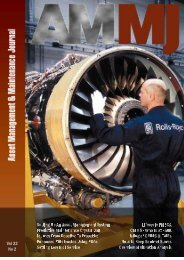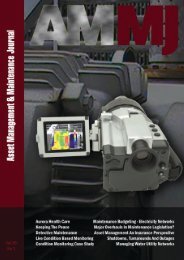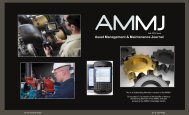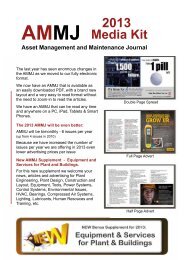July - AMMJ
July - AMMJ
July - AMMJ
Create successful ePaper yourself
Turn your PDF publications into a flip-book with our unique Google optimized e-Paper software.
Effective Thickness of Corroded Steel Plates<br />
44<br />
<strong>AMMJ</strong><br />
4.2 Comparison of Proposed Effective Thickness<br />
The experimentally predicted thickness (Eq. 3 and Eq. 4) and the representative thickness which were valued<br />
by different methods were examined and compared to understand the effectiveness of the proposed method of<br />
estimating the remaining strength capacities of corroded steel plates. The following Figure 8 shows the behavior of<br />
representative thickness, valued by different methods and the experimental tensile effective thickness (t e_b ).<br />
Figure 8 shows that the strength estimations obtained by the effective thickness values proposed by all Matsumoto<br />
et al 1989, Muranaka et al 1998 and Kariya et al 2003 are rather overestimated. So, this could lead the corroded<br />
structures to be at risk as their actual remaining capacities are lesser than that of the predicted. But, the “Proposed”<br />
method is much closer to the actual conditions.<br />
The Table 3 shows the coefficient<br />
of correlation values of the<br />
available different methods and<br />
the proposed method of effective<br />
thickness in estimating remaining<br />
yield and tensile strengths. It<br />
clearly shows that the proposed<br />
effective thickness parameter<br />
gives more reliable and better<br />
prediction with the experimentally<br />
analyzed results than other<br />
available methods.<br />
5.0 Conclusions<br />
The 42 specimens taken out of the scrapped plate girder which had been used for about 100 years with severe<br />
corrosion, was used to perform the tensile tests to clarify the relationship between the representative effective<br />
thickness (t eff ) to estimate the mechanical properties of corroded plates and their level of corrosion. A representative<br />
effective thickness equation derived by using initial thickness and maximum corroded thickness (derived with<br />
minimum thickness) to estimate their remaining yield and tensile strengths is discussed from those experimental<br />
results.<br />
The main conclusions are as follows:<br />
1. The corrosion causes strength reduction of steel plates and minimum thickness ratio ( ) can ( yn be / y ) used ( bn /as b ) a<br />
yn y t eff =<br />
measure of the level of corrosion and their strength degradation. Therefore, three basic corrosion P categories can be<br />
y Pb<br />
<br />
<br />
defined, Minor Corrosion ( > 0.75), ( yn /Moderate y ) ( bn b ) Corrosion yn y t eff = (0.75 t 0 + ≥ (1-) ≥ t min 0.5) ( yn () and / y ) Severe (t<br />
bn e _/ y b ) Corrosion yn y t eff = ( t < 0.5) according<br />
B<br />
to their severity of corrosion.<br />
e t _<br />
b 0 + (1-) ( yn / t min y ) ( () bn / b ) t<br />
e yn _ y <br />
y t<br />
y<br />
B b<br />
B<br />
2. A representative effective thickness (t eff ), based on the initial thickness (t 0 ) and maximum corroded thickness<br />
(t c,max ) can be used to estimate the remaining yield and tensile strength of corroded steel plates. In estimation of<br />
both remaining yield strength and tensile strength, the proposed relationship revealed a good comparison with the<br />
experimental results and the derived equation is as follows:<br />
t eff = t 0 - 0.8 t c,max<br />
As the proposed effective thickness equation has only a single variable, maximum corroded thickness (t c,max ), which<br />
is an easily measurable parameter and the value of initial thickness (t 0 ) is a well known parameter, it will reduce the<br />
contribution of errors occurring during the practical investigation of a corroded member. Also it is necessary to note<br />
that the t max should be applied for very old bridges in which t 0 may not be known in very rare situations. Further this<br />
method is simple and gives more reliable and closer results compared to the other available methods.<br />
References<br />
Table Table 3: Comparison 3 Comparison of correlation of correlation coefficients coefficients of different of representative different representative<br />
thickness prediction<br />
methods<br />
thickness prediction methods<br />
Method<br />
Matsumoto<br />
et al. 1989<br />
Muranaka<br />
et al. 1998<br />
Kariya<br />
et al. 2003<br />
Proposed,<br />
Equation of thickness t sa t avg – 0.7 st t avg – 1.3 st t 0 - 0.8 t c,max<br />
Correlation<br />
Yield - - - 0.89<br />
Coefficient Tensile 0.88 0.04 0.81 0.90<br />
[1] A. Kariya, K. Tagaya, T. Kaita and K. Fuji [2003], ‘Basic study on effective thickness of corroded steel plate and<br />
material property’, Annual conference of JSCE, pp 967-968. (In Japanese)<br />
[2] A. Kariya, K. Tagaya, T. Kaita and K. Fuji [2005], ‘Mechanical properties of corroded steel plate under tensile<br />
force’, Proceedings of the 3rd International Structural Engineering and Construction Conference (ISEC-03), Japan,<br />
pp 105-110.<br />
[3] A. Muranaka, O. Minata and K. Fujii [1998], ‘Estimation of residual strength and surface irregularity of the<br />
corroded steel plates’, Journal of Structural Engineering, vol. 44A, pp 1063-1071 (In Japanese).<br />
[4] ‘Corrosion Protection of Steel Bridges’, Steel Bridge Design Handbook, Chapter 23, National Steel Bridge<br />
Alliance.<br />
[5] I. Sugimoto, Y. Kobayashi and A. Ichikawa [2006], ‘Durability Evaluation Based on Buckling Characteristics of<br />
Corroded Steel Deck Girders’, QR of RTRI, Vol. 47, No.3, pp 150-155.<br />
[6] K. Fuji, T. Kaita, H. Nakamura and M. Okumura [2003], ‘A Model Generating Surface Irregularities of Corroded<br />
Steel Plate for Analysis of Remaining Strength in Bridge Maintenance’, The 9th East Asia-Pacific Conference on<br />
Structural Engineering and Construction (EASEC-9), Vol. 9, pp 32-38.<br />
[7] M. Bruneau and S.M. Zahrai [1997], ‘Effect of Severe Corrosion on Cyclic Ductility of Steel’, Journal of Structural<br />
Engineering, Vol. 123, No.11 pp 1478-1486.<br />
t eff<br />
Vol 24 No 3




